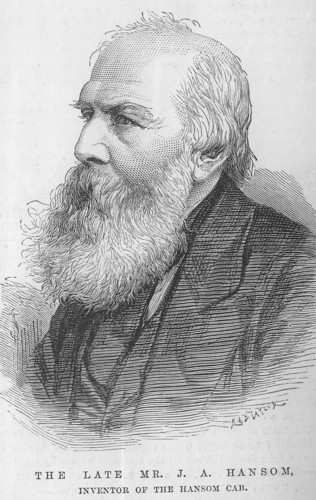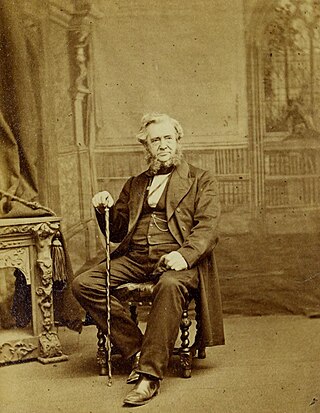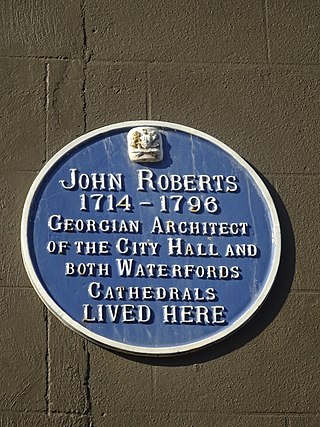
Joseph Aloysius Hansom was a British architect working principally in the Gothic Revival style. He invented the Hansom cab and founded the eminent architectural journal The Builder in 1843.
The year 1863 in architecture involved some significant architectural events and new buildings.

Patrick MacDowell was a Belfast-born British sculptor operating through the 19th century.

Anne Elizabeth "Elsie" Fogerty was a British teacher who departed from the customary practice of "voice and diction" also called elocution. At that time "Voice and Diction" focused entirely on the mouth and nasal cavity to produce speech sounds. Fogerty's technique ended up focusing on the entire body and voice to produce speech. At first, she used just the lungs to resonate the sound, but soon included the whole body, because she discovered that posture and movement also affected speech. It ultimately became known as the "Body and Voice" technique. She was founder and principal of the Central School of Speech and Drama in London from 1906 to 1942.

Mount Jerome Cemetery & Crematorium is situated in Harold's Cross on the south side of Dublin, Ireland. Since its foundation in 1836, it has witnessed over 300,000 burials. Originally an exclusively Protestant cemetery, Roman Catholics have also been buried there since the 1920s.

Robert Bent Knox was the Church of Ireland Bishop of Down, Connor and Dromore from 1849 to 1886, and then Archbishop of Armagh and Primate of All Ireland from 1886 until his death.

Thomas George Southwell, 1st Viscount Southwell was an Anglo-Irish military officer, peer and politician who served as the governor of Limerick from 1762 to 1780.

Thomas Kirk was an Irish sculptor.
Andrew Devane was an Irish architect, born in Limerick. He studied architecture at University College Dublin under Rudolf Maximilian Butler where he graduated in 1941. In 1946 he was awarded the Taliesin Fellowship and he left Ireland for the United States to study under Frank Lloyd Wright until 1948. In 1948 he re-joined Paddy Robinson and Cyril Keefe of the architectural practice of Robinson & Keefe as a partner.

Colonel Thomas de Burgh, always named in his lifetime as Thomas Burgh, was an Anglo-Irish military engineer, architect, and Member of the Parliament of Ireland who served as Surveyor General of Ireland (1700–1730) and designed a number of the large public buildings of Dublin including the old Custom House (1704–6), Trinity College Library (1712–33), Dr Steevens' Hospital (1719), the Linen Hall (1722), and the Royal Barracks.
William Fogerty, FRIAI, FRIBA, AAI was an Irish architect active in mid-nineteenth-century Limerick, London, New York City and Dublin.
Joseph Fogerty, CE, FRIBA, (1831-1899) was an Irish civil engineer, architect, and novelist active in mid-to-late-nineteenth-century Limerick, London, and Vienna.

John Fogerty was an Irish millwright, architect, builder, and civil engineer, active in early to mid-19th-century Limerick.He was the brother of Joseph Fogerty Sr. and the father of engineer and novelist Joseph Fogerty of London, architect William Fogerty of Dublin, and grandfather of architect John Frederick Fogerty. He retired as an architect sometime between 1870 and 1879.
John Frederick Fogerty (1863–1938), was an Irish architect and engineer active late 19th-century Limerick, London, Shropshire, Bournemouth, Pretoria, and Zambia. Born in Limerick, he was the son of architect William Fogerty, grandson of architect and engineer John Fogerty (engineer), and nephew of engineer and novelist Joseph Fogerty. He earned a bachelor's degree in engineering from Queen's College, Cork in 1883, and attended the South Kensington Art School the year later. He was articled to Sir Thomas Drew. In 1889, he established his office at Wellington, Shropshire, and entered into partnership with Reginald George Pinder in Bournemouth in 1893, later amalgamating Pearce & Parnell of Bournemouth in 1902. He emigrated to South Africa in 1914 and enlisted at the outbreak of the First World War, serving time in South Africa, the Isle of Wight, Palestine, and Poona, India. During the interwar period, he worked as an engineer in Pretoria's Public Works Department, before becoming borough surveyor in Lusaka, Zambia, in 1926, where he died in 1938.
Joseph Fogerty & Son was an Irish architectural firm active from the 1870s until 1887 in Limerick and throughout the west of Ireland. It was composed of Joseph Fogerty Sr. and his son Robert Fogerty.
John H. Brett (1835–1920) was an Irish architect, builder, and county surveyor for counties Limerick, Kildare and Antrim, active in late-nineteenth to early twentieth-century Ireland. He was notable in being a prolific designer of utilitarian structures as a county surveyor, with many practical schemes proposed. His designs, however, were often flamboyant in practicing a Ruskinian Gothic blend of Victoian Italianate and Venetian Renaissance styles, heavily influenced by the writer John Ruskin (1819–1900).
John Fogerty may refer to:

Alfred Edwin Jones (1894–1973) was an Irish architect. His collection of files about Irish architects formed the basis of the Dictionary of Irish Architects 1720–1940.
Sancton Wood was an English architect and surveyor, known for his work on railway buildings.

John Roberts was an Anglo-Irish architect of the 18th century, working in the Georgian style. Born in the city of Waterford, he is best known for the buildings he designed in that city.










